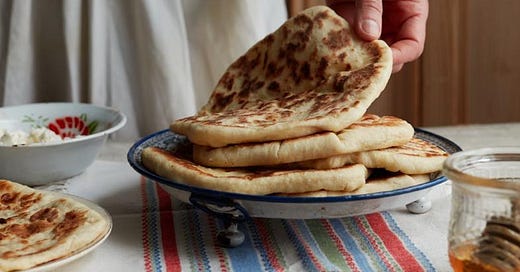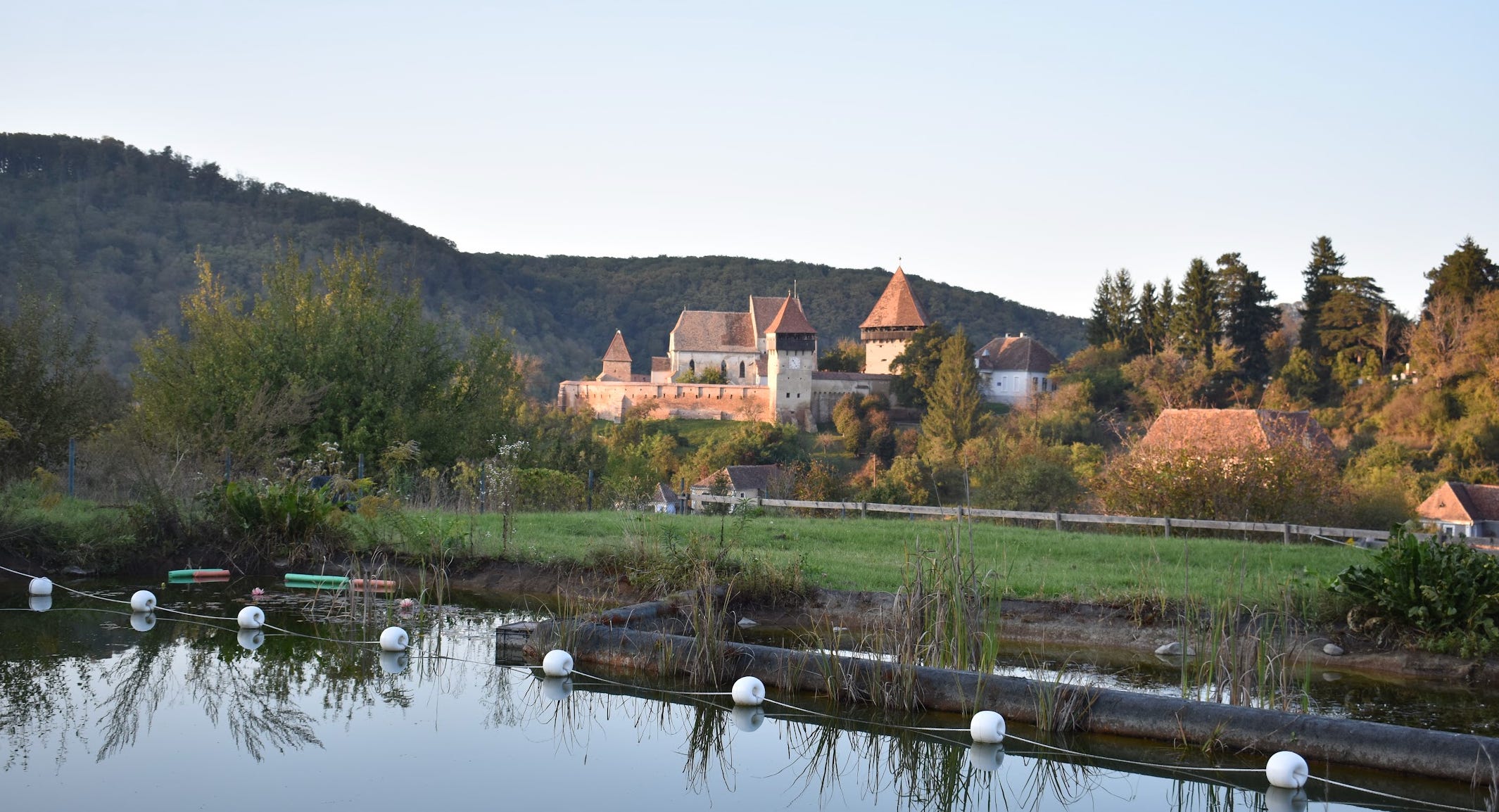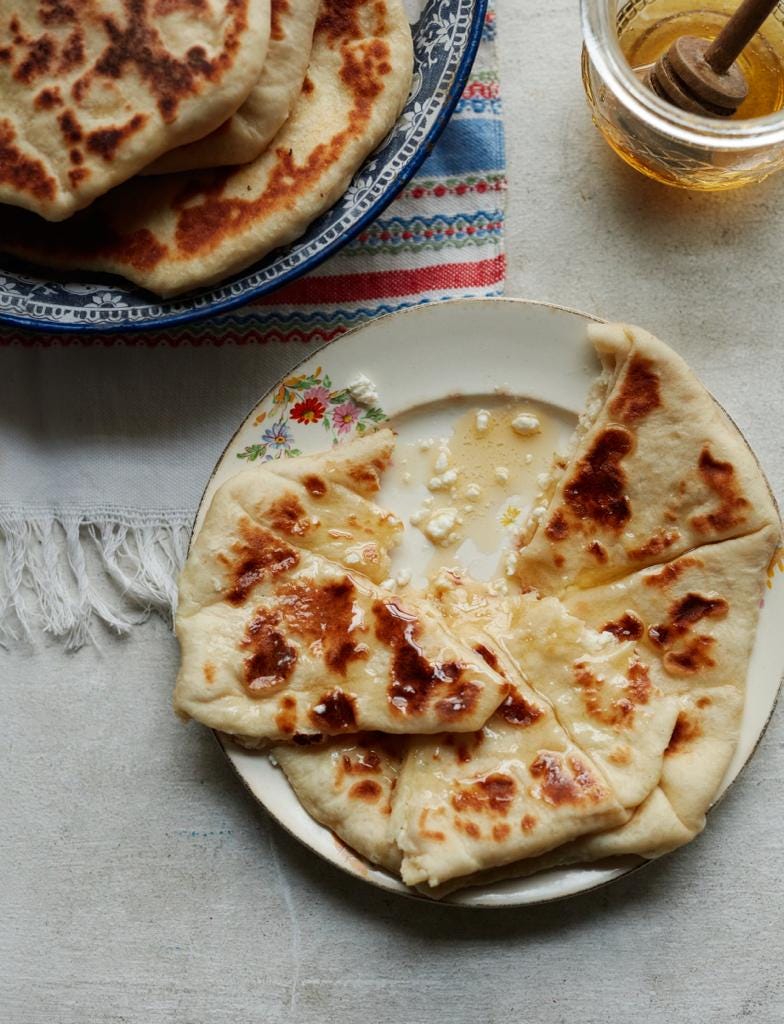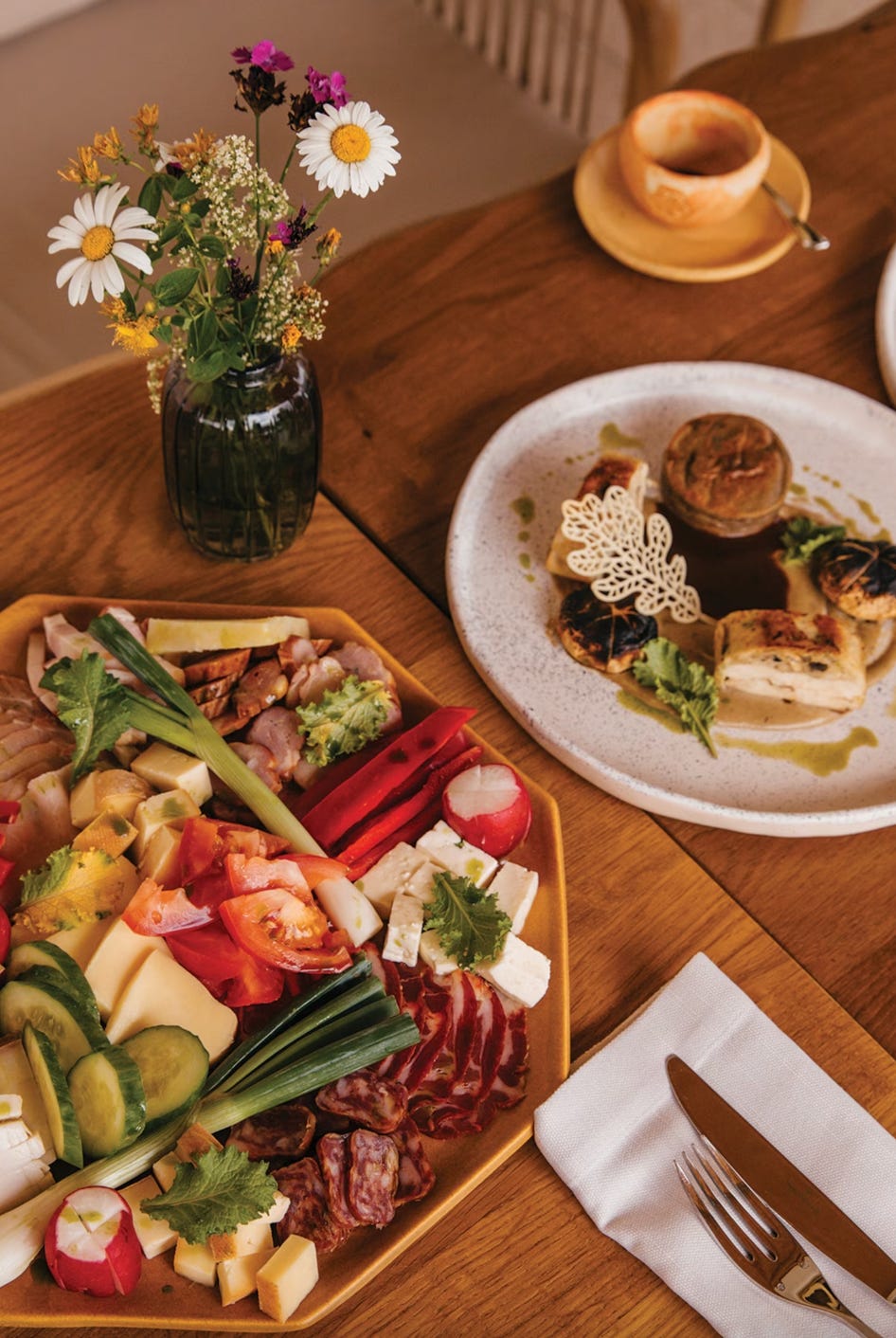Plăcinte pe lespede
It appears I talk a lot about plăcinte. This is a true reflection of how we eat in Romania, where we enjoy many different types of pies known as plăcinte. One recipe that many of you liked a few weeks ago was this sweet pie with pumpkin, which felt familiar yet intriguing enough to have its distinct charm. Usually, a plăcintă like this is rectangular, cut into slices, and left on the table for a snack.
Transylvanian griddle breads are slightly different: they are round and served warm. Sweet or savoury, they are still a snack rather than a full meal. Popular fillings are cheese, potatoes, cabbage, herbs or jam. You make them to appease your sudden hunger or while you are waiting for the main course to be served.
Longing and belonging
It’s best to eat these Transylvanian plăcinte as soon as they are ready. Yes, they will be hot when you first hold one in your hands, so pretend you are playing the piano on the crust, trying not to burn all your fingers at once. Then, when you tear one open, a warm mist of herbs, garlic and hearty potatoes soars up towards your nostrils. Inhale it! It feels comforting, no matter if it’s summer, autumn or winter. It’s a dish that takes us back to when food was simple and ingredients were humble. To me, this is a place I long for, a place where I truly belong.
Lespede
In Romanian, the word "lespede" means "stone slab" and, in Transylvania, it refers to a cherished traditional baking stone used for cooking pies. Historically, these baking stones were so valued in the region’s culture that they were frequently part of a young woman's dowry. Today, we can also enjoy making them using a cast iron griddle over an open fire or a griddle pan right on the stove.
This is how we bake them on our Culinary Tour in Transylvania: on cast iron griddles at Mesendorf 65 with Oana and Adrian Udrea. In fact, this is part of a hands-on cooking course, so everyone gets to learn how to make them.
10th-15th September 2025, Culinary Tour in Transylvania
Here are the updated dates for next year, link here, and you can reserve your spot now or email me for details. I will be your culinary guide for six wonderful days of delicious food and drink. We will explore Saxon Transylvania, and visit its UNESCO-listed fortified churches, followed by more eating and drinking. You’ll also meet artisan producers and local cooks, participate in hands-on cooking classes, and enjoy tasting experiences throughout this region of Transylvania.
Transylvanian sweet griddle breads with cheese and honey - the recipe
Ingredients
Make 6 pies
For the filling:
180 g curd cheese (Romanian brânză de vaci or set cottage cheese)
3 tablespoons sunflower oil, for cooking
Runny honey, for drizzling
For the dough
300 g plain (all-purpose) flour, plus extra for dusting
20 g golden caster (superfine) sugar
7 g (1 sachet) fast-action dried yeast
80ml water
3 tablespoons milk
2 tablespoons sunflower oil
5g of fine salt
Method
If you are using cottage cheese for the filling, drain it of any excess water beforehand by placing it in a fine sieve over a bowl.
Make the dough by combining all the ingredients together in a bowl, then knead until soft and silky. Add a splash of water if needed. Cover and leave to rest at room temperature for 1 hour.
Set a cast-iron or non-stick frying pan (skillet) over a medium–high heat.
Flour your work surface and hands generously, then divide the dough into 6 equal parts. Roll one piece out to a circle, 25–30 cm (10–12 in) in diameter. Crumble (or spread) a sixth of the cheese on top. Bring the sides to the middle in 7 or 8 folds, overlapping them slightly, then press with your hands or gently use a rolling pin to flatten and seal them. Repeat until you have 6 filled breads ready to be cooked.
Oil the hot pan with about 1/2 tablespoon of oil. Cook each pie on both sides for 3-4 minutes until golden brown. Transfer to a plate and cover with a beeswax wrap or a reusable plastic bag (the steam will keep them soft) while you cook the rest.
Serve warm, drizzled with honey.
Savoury fillings
To make savoury pies, reduce the sugar in the dough to 5g.
Potato and caraway: use 2 large potatoes, diced, boiled, and slightly crushed with salt, pepper, grated garlic and toasted caraway seeds.
Cheese and dill: use 180g curd cheese, Romanian telemea, crumbled Feta or grated Cheddar, salt and 25g finely chopped dill or fennel.
Cabbage: My auntie in Transylvania called them vărzări or pupuri. Stew a small white cabbage together with one large onion until tender, adding plenty of ground black pepper.
In the media:
My Transylvanian griddle breads in the Washington Post, link here
Culinary Transylvania in the National Geographic Traveller UK, link here
Romania and my books in the National Geographic Traveller UK
6 must-try dishes in Bucharest, from radish roses to fondue polenta, link here
Mountains of flavour: Irina Georgescu on Romanian cuisine, link here
Food writer Irina Georgescu on the culinary culture of Romania, link here
7 of the best Romanian Easter dishes, link here.










Thanks for sharing this recipe! I definitely want to make these this season.
Thanks for sharing Irina. They look delicious.